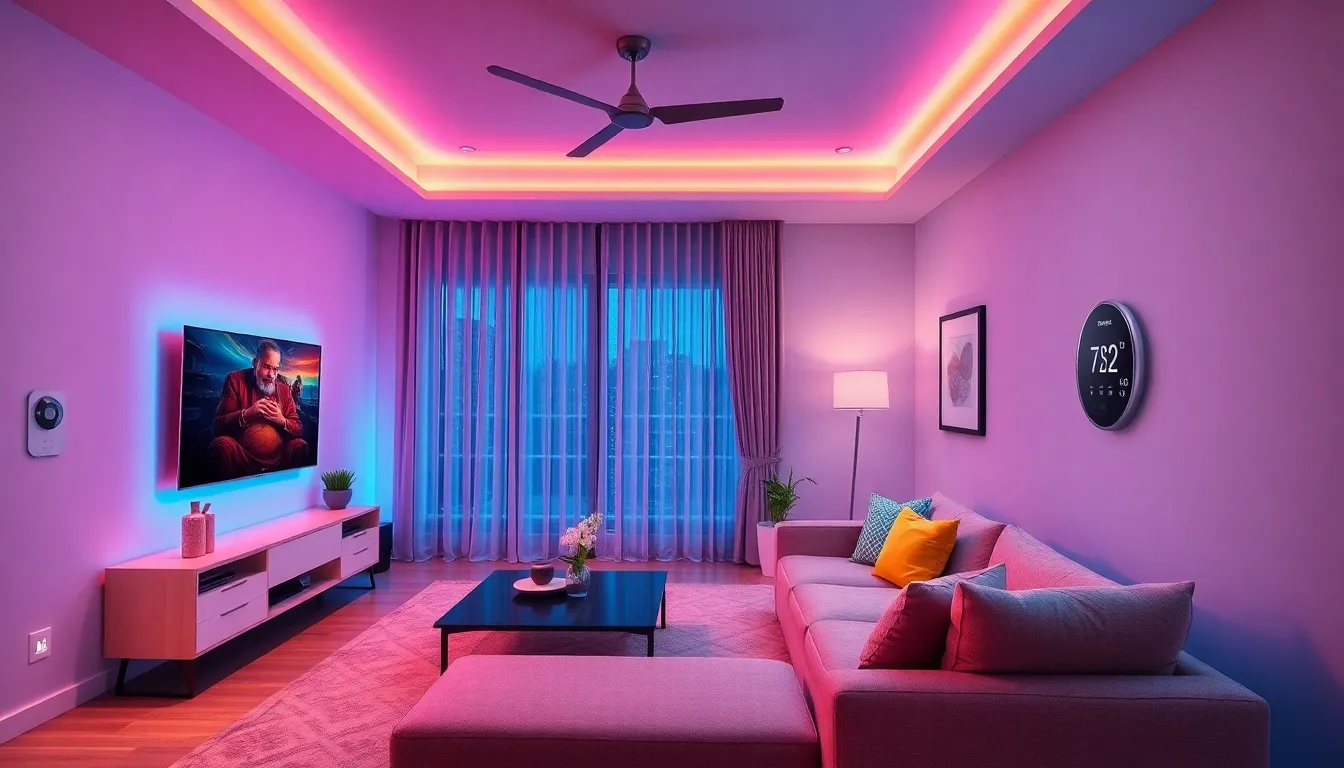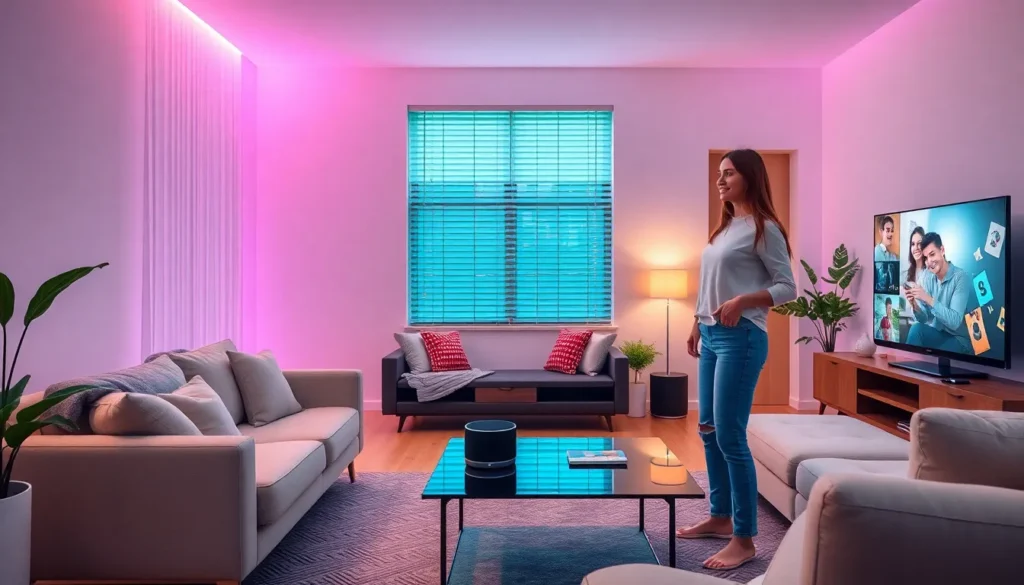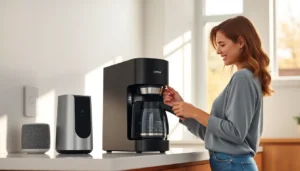Imagine a living room that practically runs itself. With a smart living room, that dream becomes a reality. It’s not just about fancy gadgets; it’s about transforming everyday life into a seamless experience. Picture this: you walk in, and the lights dim to your favorite movie-watching setting while the aroma of freshly brewed coffee fills the air. Sounds like a scene from a sci-fi flick, right?
Table of Contents
ToggleWhat Is a Smart Living Room?
A smart living room integrates technology to enhance daily life. This space utilizes advanced devices to automate tasks, providing convenience and comfort. Lighting systems adjust based on occupancy and preferences, creating an inviting atmosphere. Smart speakers allow for voice control over music, news, and home settings.
Different devices often work together to streamline activities. For instance, smart TVs display content based on user preferences while connecting to streaming services. Thermostats can learn habits and adjust temperatures for optimal comfort. Security cameras provide peace of mind, offering real-time monitoring and alerts.
Integrating home automation systems enhances the experience further. Users can control everything from blinds to entertainment devices through a unified interface. This interconnectedness promotes energy efficiency, reducing utility costs. Consumers can also personalize environments with customizable settings for lighting, audio, and temperature.
Examples of smart devices include smart plugs, which allow manual or remote control of appliances. Smart displays serve as information hubs, permitting access to calendars, reminders, and communication. Home assistants often coordinate entire ecosystems, facilitating communication among gadgets.
Ultimately, a smart living room not only promotes efficiency but also improves lifestyle quality. By merging technology with design, these spaces create seamless living experiences. The focus on automation supports users in achieving comfort and security, embodying the future of home environments.
Key Features of a Smart Living Room

A smart living room enhances comfort and convenience through the integration of various advanced technologies.
Smart Lighting
Smart lighting adapts seamlessly to user preferences. Automated systems can dim or brighten lights based on the time of day. Motion sensors activate lights upon entry, providing instant illumination. Users can control light colors and intensities via smartphone apps or voice commands. Programs adjust lighting to suit activities, from reading to movie watching. With energy-efficient LED bulbs, these systems contribute to reduced energy consumption. Smart lighting offers a customizable ambiance that enhances the living environment.
Smart Entertainment Systems
Smart entertainment systems prioritize user experience with convenience and personalization. Unified platforms allow seamless control of TVs, speakers, and streaming devices. Voice commands enable quick access to favorite shows, movies, or music playlists. Integrating devices can recommend content based on viewing history, making entertainment intuitive. Connectivity to smart assistants enhances voice control capabilities for an interactive experience. Systems can also schedule content reminders, ensuring users never miss their favorite programs. Efficiently designed, these entertainment systems transform leisure time into an immersive experience.
Smart Climate Control
Smart climate control optimizes comfort by learning user preferences. Thermostats can adjust temperature settings based on occupancy, promoting energy savings. Users can program schedules or control the system remotely through apps. Sensors keep track of humidity levels, enhancing air quality. Integration with ventilation systems circulates air efficiently throughout the living room. Alerts notify users of significant changes, ensuring a consistent comfort level. Well-designed climate control systems foster a pleasant atmosphere while reducing energy costs.
Benefits of a Smart Living Room
A smart living room combines technology and comfort, offering numerous advantages that enrich daily life.
Convenience and Automation
Convenience enhances every moment in a smart living room. Voice commands control various devices, making tasks effortless. Automated settings adjust lighting and entertainment based on preferences or schedules. Smart devices communicate with each other, creating a unified home ecosystem. Users experience seamless transitions, like having coffee ready upon arrival. This level of automation eliminates the need for manual adjustments or multiple remotes. Through personalized scenarios, relaxing evenings or efficient mornings become the norm. Everyday interactions transform into enjoyable experiences, whether it’s playing music, dimming lights, or starting a movie.
Energy Efficiency
Energy efficiency becomes a key focus in a smart living room. Smart devices manage energy consumption by adjusting usage according to presence and time of day. Occupancy sensors automatically turn off lights in empty spaces, significantly reducing electricity bills. Programmable thermostats learn user patterns, optimizing heating and cooling for maximum savings. Moreover, energy-efficient LED bulbs replace traditional lighting, consuming less power. With data-driven insights, homeowners gain a clearer understanding of their energy use. Sustainable living practices are easily integrated into daily routines, supporting both budget and environment. Overall, smart living rooms not only provide comfort but also promote eco-friendly habits throughout the home.
Setting Up Your Smart Living Room
Setting up a smart living room involves selecting appropriate devices and creating seamless connections between them. Careful planning enhances the overall experience while ensuring efficient operation.
Choosing the Right Devices
Identifying essential devices is crucial for a smart living room. Smart bulbs adjust brightness and color based on preferences. Smart speakers facilitate voice control, allowing for easy access to music and information. Smart TVs offer personalized content recommendations based on viewing habits. Smart plugs help control conventional appliances remotely. Each device plays a pivotal role in creating an integrated system that adds convenience and comfort to daily routines.
Integrating with a Smart Home Hub
A smart home hub acts as the brain of the system, connecting all smart devices. Coordinating various functionalities enhances user experience through centralized control. Homeowners use a single app to manage lighting, temperature, and entertainment. Integration facilitates scenarios like turning off lights and adjusting thermostats automatically. Selecting a compatible hub maximizes the functionality of connected devices, creating a cohesive living environment that simplifies interactions and promotes energy efficiency.
A smart living room represents the future of home design where technology and comfort converge. It enhances daily routines through automation and connectivity, making life more convenient and enjoyable. With the integration of various smart devices, homeowners can create personalized environments that cater to their unique preferences.
This innovative approach not only improves efficiency but also promotes eco-friendly practices, leading to significant energy savings. By embracing a smart living room, individuals can transform their homes into havens of comfort and security. As technology continues to evolve, the possibilities for creating the ultimate smart living space are limitless, ensuring a seamless and enriching lifestyle for everyone.





